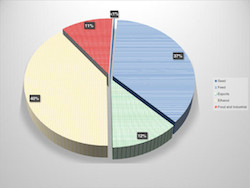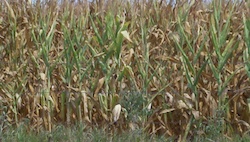A study done by researchers at the University of Illinois’ College of Agricultural, Consumer, and Environmental Sciences, has found that several factors will lower the need for land used to produced corn-based ethanol to as little as 11 percent of the corn acres by 2026 when adhering to the U.S. Environmental Protection Agency’s 15 billion gallon ceiling on domestic ethanol production.
The researchers note that a too common error made in reporting land used for domestic  production is to measure the amount of grain shipped to ethanol manufacturers, compute the number of acres required to produce the grain and then end the analysis. However, the researchers say this is a gross oversimplification that leads to incorrectly concluding that 40 percent or more of U.S. corn acres are used for ethanol production. The real number, according to the research team is less than 25%. The reason is that most studies don’t account for the grain being used as high-value animal feed (distillers grains or DDGs).
production is to measure the amount of grain shipped to ethanol manufacturers, compute the number of acres required to produce the grain and then end the analysis. However, the researchers say this is a gross oversimplification that leads to incorrectly concluding that 40 percent or more of U.S. corn acres are used for ethanol production. The real number, according to the research team is less than 25%. The reason is that most studies don’t account for the grain being used as high-value animal feed (distillers grains or DDGs).
The new study, conducted by Professors Rita H. Mumm, Peter D. Goldsmith, Kent D. Rausch and Hans H. Stein, explores the impact of technological improvements on corn grain production, ethanol production, and their interrelated effect on land use through a variety of scenarios over a 15 year period beginning in 2011, the year used to establish the base case. The researchers found that land area attributed to corn ethanol will consistently drop because plant breeding improvements and new technologies will result in significantly higher yields.
In addition, over the next decade, corn yields will improve significantly which will greatly reduce land use attributed to ethanol manufacturing. On the higher end of the spectrum, the study finds yields will increase by almost 100 bushels per acre, which represents 66 percent growth. The majority of this contribution will come from conventional breeding, with advanced breeding technology, biotechnology and agronomic improvements together contributing almost half.
“It’s no surprise to the agriculture industry that yield improvements will drive down land used for ethanol,” said Dr. Rita Mumm, coauthor of the study. “However, the mechanisms within the production complex, especially their effects on one another, were not fully understood. This work provides a clear picture on current land use and provides an approach for evaluating future land use.”
In addition to the yield improvements, the study finds better use will be made of grains as animal protein producers optimize utilization of feed options which includes balancing DDGS with use of corn grain and soybean meal to take advantage of market efficiencies. One slight surprise identified in the study is a tradeoff between raising ethanol production efficiency and land use. Improved efficiencies in the ethanol m anufacturing process raise ethanol yield per bushel of corn 12 percent while reducing DDGS production 27 percent. The sharp reduction in DDGS output raises ethanol’s land use one percentage point, or 800,000 acres by 2026 compared to the base scenario.
anufacturing process raise ethanol yield per bushel of corn 12 percent while reducing DDGS production 27 percent. The sharp reduction in DDGS output raises ethanol’s land use one percentage point, or 800,000 acres by 2026 compared to the base scenario.
The multidisciplinary team of researchers developed a model of the U.S. corn ethanol system that factored in all ethanol inputs and outputs: corn grain, processing co-products, livestock feeding and oil from replaced soybeans that would otherwise go for biofuels. Seven scenarios were then outlined to evaluate a spectrum of corn yield outcomes, advancements in the ethanol manufacturing process and a range in animal feed solutions. The scenarios were modeled at three time horizons: 2011 (current); the time at which 15 billion gallons of corn ethanol is reached; and 2026 (15 years).
“One exciting component of this study is that it details for the first time the interrelated effects of technologies across corn production, ethanol production and, to lesser extent, animal production.” Dr. Mumm added. “Moving forward, science must weigh anticipated technological changes to fully understand trends in land use. Technology has a huge bearing on actual results as we’ve shown.”

